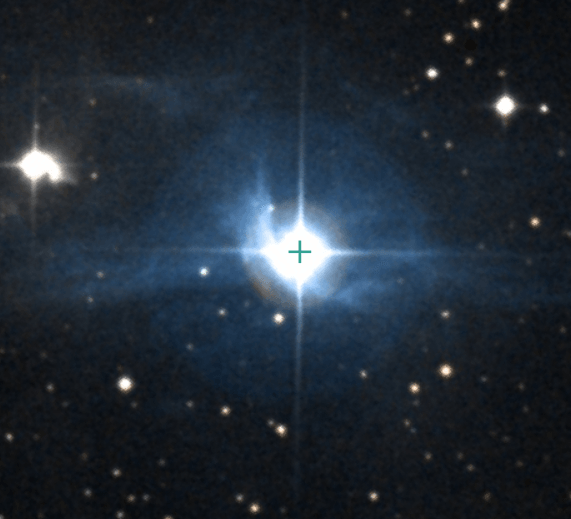Star of the Month
AB Aurigae
AKA: HD 31293. Position: 04 hrs 55 min 46 sec 30 degrees 33 min 04 sec
Due south at 21:15 (GMT) on 15 January
AB Aurigae
Image: Simbad (http://simbad.u-strasbg.fr/simbad/)
AB Aurigae is currently attracting a lot of scientific interest because of the data from the Atacama Large Millimeter Array (ALMA). It is a young star, 531 light years from us, which is between two and four million years old. In technical terms a Herbig Ae/Be type star. These stars are pre-main sequence, less than 10 million years old, display emission spectra (hence the “e”), and are embedded in dust and may have protoplanetary discs. Because of the dust, they display an excess of infrared radiation. They should not be confused with classical Be stars (such as Gamma Cassiopeiae, star of the month for November 2020) which have already joined the main sequence. When we say that a star has not joined the main sequence, we mean that it has not yet begun nuclear fusion in its core. If like T Tauri (star of the month for December 2020), it had just started undergoing fusion, the dust would be pushed away rather than surrounding the star. AB Aurigae itself is a Herbig Ae star, as it is type A and 2.4 times heavier than the Sun. The dust envelope around AB Aurigae is so extensive that it can be seen with the Hubble Space Telescope and even in the picture above. ALMA shows the dust ring with a radius of 120 AU and within it spiral arms of gas which are probably planets being formed at this very moment.
Both AB Aurigae and T Tauri are within the Taurus Molecular Cloud. This is a cloud of cold molecular hydrogen along with other molecules, some of which are quite complex such as cyclopropenone (C3H2O) which was first made on Earth in 1972. The existence of these clouds is crucial for star formation for two reasons: they are cold and they contain molecules. On the face of it, a cold cloud (and I mean really cold, about 10-15K) does not seem a promising starting place for a very hot object like a star, but if the gas is warm, it expands and therefore cannot condense to form a star. But cold gas is not sufficient on its own. As a gas condenses and is pulled inwards by gravitational attraction, it is compressed and liberates heat. In the absence of a mechanism to remove this heat, the gas will expand and the formation of the star will be halted before it has even started. This is where the molecules come in. Unlike atoms, molecules have bonds which can absorb heat which they use to bend and stretch the molecules. The gas thus remains cold and the gravitational contraction can continue. Surprisingly you can readily observe a young pre-main sequence star, such as AB Aurigae. It is magnitude 7.1 and thus easy to see in binoculars or a small telescope. Draw a line from Iota Aurigae to the ground, and then bisect it with a line between Alnath (Beta Tauri) and Zeta Persei, and where they meet you should find AB Aurigae. It is technically a variable star, but for most of the time, the variation is slight, it has been described as a “flickering”. Unless you have a large telescope or use imaging you are unlikely to see the dust surrounding the young star, but you can at least envisage it in your mind’s eye.

